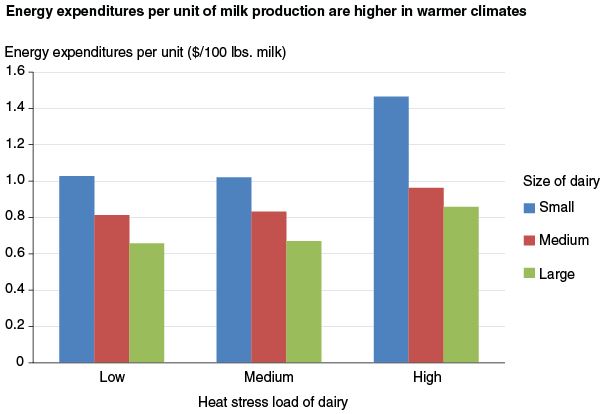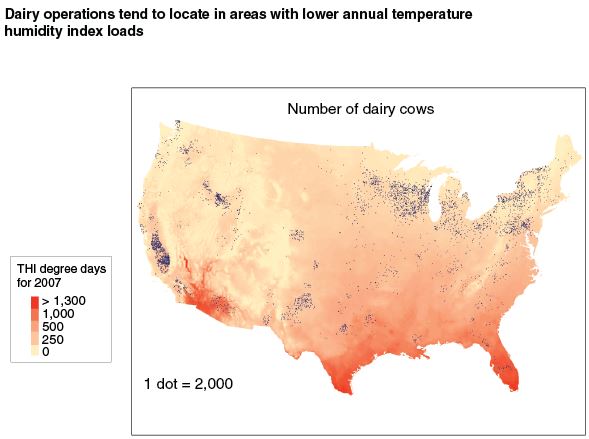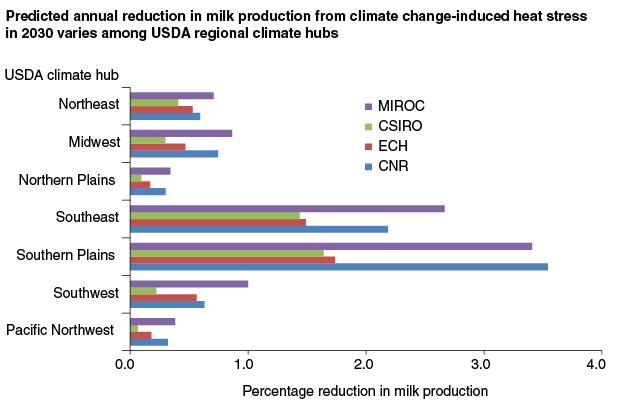



Climate Change Could Lower Milk Yields Through Heat Stress
In many parts of the United States, climate change is likely to result in higher average temperatures, hotter daily maximum temperatures, and more frequent heat waves, which could increase heat stress for livestock, writes the US Department of Agriculture.
Heat stress can reduce meat and milk production and lower animal reproduction rates. Livestock producers can mitigate heat stress with shade structures, cooling systems, or altered feed mixes, but these methods increase production and capital costs. Dairy cows are particularly sensitive to heat stress; higher temperatures lower milk output and milk quality.
A recent ERS study quantifies the costs of climate change-induced heat stress to the U.S. dairy industry. The study used operation-level economic data coupled with climate data to estimate how the local thermal environment affects milk output. This information is used to estimate the potential decline in milk production in 2030 resulting from climate change-induced heat stress. The results indicate modest heat stress-related production declines over the next 20 years, with the largest declines occurring in the South.
Heat Stress Lowers Dairy Productivity
Every animal has an optimal range of temperatures in which it can maintain a normal body temperature without altering its physiological functions or behavior. Above these temperatures, an animal may experience heat stress resulting in changes in respiration rate, heart rate, sweating, blood chemistry, hormones, metabolism, and behavior. Animals under heat stress generally increase their water intake and reduce their feed intake.
Because of the high metabolic heat production associated with rumen fermentation and lactation, dairy cattle are particularly sensitive to heat stress. Higher temperatures lower milk output and reduce the percentages of fat, solids, lactose, and protein in milk.
Heat stress also reduces the fertility of dairy cows, lowering reproduction rates. To combat heat stress, dairy producers can make long-term investments and alter shortrun production decisions. Farmers can mitigate heat stress by providing trees, buildings, or portable structures for shade. Studies have shown that shade in combination with cooling (spray and fans) can offset decreases in milk production and reproductive efficiency resulting from heat stress.
Cows that were cooled with sprinkling and ventilation were found to consume more food and less water and to increase milk, fat, and protein production.
Farmers’ efforts to cool cows using ventilation would likely increase energy use. The 2010 Agricultural Resource Management Survey (ARMS) data show that dairies in the warmest regions have higher energy expenditures per unit than those in cooler regions. For example, large dairies spend an average of $0.86 per hundredweight of milk on energy in the warmest regions, compared to $0.66 in cooler regions.
Altering feed rations can also reduce the effect of heat stress on dairy cattle. Heat stress substantially increases the energy required to maintain a normal body temperature, reducing the energy available for meat or milk production.
At the same time, heat stress induces cattle to reduce their feed intake. To compensate for these changes, dietary recommendations include increasing the nutritional quality of forages, lowering fiber content, and increasing fat levels and digestibility of feed. Other recommendations include altering feeding times to coincide with the cooler times of the day and reducing the effort required by animals to access food, minerals, and water.
A possible adaptive response to a warming climate is to cross dairy breeds to take advantage of the relative vigor of first-generation crosses. Another option is to switch to breeds of cattle that are better suited to high temperatures.
Studies have found that Jerseys exhibit smaller declines in milk production when exposed to heat stress than Holsteins. The 2010 ARMS data show that Jersey cows were more common on dairies located in warmer regions. Among small- and medium-scale dairies, those in the highest heat load regions have a much greater share of Jersey cows in their herds, suggesting breed selection is being used to cope with heat stress.
How Much Does Heat Stress Lower Milk Output?
ERS researchers used a measure of heat stress— the temperature humidity index (THI) load— to quantify the relationship between climate and dairy production. The THI is a combined measure of ambient temperature and relative humidity and has been shown to better quantify heat stress on livestock than temperature alone.
An upper critical THI defines when an animal begins to exhibit heat stress. For lactating dairy cows, the upper critical THI threshold is about 70 humidity-adjusted degrees. The THI load (measured in humidity-adjusted degree hours or days) measures the duration and extent that an animal in a particular location is above its critical THI threshold. The annual THI load is similar to “cooling degree days,” a concept often used to convey the amount of energy needed to cool a building in the summer.
The THI load, based on daily weather data from 1990 to 2005, is greatest in the South and lowest in the North and in mountainous regions. In general, dairy production is concentrated in climates that expose animals to less heat stress. Dairy cows are concentrated in California’s Central Valley, Idaho, Wisconsin, New York, and Pennsylvania. Few dairies are located in the very warm Gulf Coast region (which includes southern Texas, Louisiana, Mississippi, Alabama, and Florida).
The relationship between heat stress (THI load) and dairy output was estimated using a statistical model that controls for input use and characteristics of the dairy operation and operator. The ERS study used data from a 2010 ARMS survey of dairies located throughout the United States. Compared to an ideal climate with no heat stress, the study finds that heat stress lowered 2010 milk production for the average dairy farm by about 183,000 pounds, worth about $39,000 at 2010 prices. This is equivalent to $1.2 billion per year in lost production for the entire U.S. dairy sector. For context, the sale of milk and other dairy products in the United States totaled $31.8 billion in 2007.
A Warmer Climate Will Lower Milk Production
To predict how much climate change-related heat stress will affect dairy cows, ERS researchers used climate forecasts from four different climate change models. These models estimate patterns of temperature and precipitation based on assumptions about future carbon emissions levels.
Using an emissions scenario that incorporates midrange assumptions about future population growth, technological change, economic growth, and international political cooperation, the predicted change in regional THI loads in 2030 can vary considerably among the four models. For all models, however, the largest increases are forecast in the South. For the sample of dairies surveyed in 2010, the average annual temperature is forecast to increase between 1.45 and 2.37 degrees Fahrenheit by 2030, depending on which climate model is used. The THI load is predicted to increase by an average of 1,670-3,940 humidity-adjusted degree hours.
Using predicted increases in local average THI loads, and the estimated relationship between THI load and dairy productivity, ERS researchers predicted how climate change will likely affect milk production.
Depending on the climate model used, the study found that a warmer climate in 2030 will reduce milk production for the average dairy by 0.60 to 1.35 percent, compared to a situation with no climate change. The value of this lost production is between roughly $2,000 and $5,000 (at 2010 prices).
Almost all (99.8 percent) dairies would experience some production loss, and 4-18 percent of operations would experience a loss greater than 2 percent. With no market adjustment, the aggregate annual value of this climate change-induced reduction in milk output for the entire U.S. dairy sector is $79-$199 million (valued at 2010 prices).
In theory, prices should increase in response to a climate-induced contraction in the milk supply, since greater heat stress lowers productivity, reducing what can be produced with the same inputs. Producers would be worse off, despite higher prices, because of their higher production costs. Consumers would also be worse off because they would face higher milk prices.
The extent of the milk price increase and the magnitude of the losses depend on how responsive consumers and producers are to prices. The value of the total reduction in milk production ranges from $32 million to $116 million, depending on the climate model and consumer/producer responses to price changes.
Consumer surplus (the difference between the maximum price consumers are willing to pay for milk and the actual price they do pay) is estimated to decline by $64-$162 million because of higher milk prices, and producer surplus (the difference between the amount that producers receive for selling milk and the minimum amount that they would be willing to accept) is estimated to decline by $42-$108 million because of higher production costs.
Some regions are likely to incur greater costs from climate change-induced heat stress level. Producers are grouped into seven USDA Regional Climate Hubs. Milk production losses, by region, range from 0.07 percent to 3.5 percent, depending on the climate model.
For individual regions, there is substantial variation across models in predicted effects, reflecting differences in climate change predictions across the four climate change models. Nonetheless, the Southern Plains and Southeast are predicted to experience the largest percentage declines in milk production, generally corresponding to the proportional increase in THI load.
While the scale of the estimated production effects from climate change in 2030 is modest, over time, climate change is likely to be much more extreme and could result in substantially higher THI loads and efficiency losses. In addition, increased heat stress is only one potential cost of climate change for the livestock sector.
Global warming will also likely alter the price and availability of feed crops, the location and productivity of pasture and rangeland, and the distribution of livestock parasites and pathogens. Estimating the magnitude of these potential effects is an important area for future research.
Adaptation to a Warming Climate Is Possible
Because climate change occurs gradually, mitigating some of the negative consequences for livestock production through research into and development of adaptive technologies and practices should be possible.
Innovations to address climate change-induced heat stress include more energy-efficient cooling for animal housing, improved heat-tolerant breeds, and improvements in scientific knowledge about the interactions between feed, nutrition, and heat stress.
With the launch of seven Regional Hubs for Risk Adaptation and Mitigation to Climate Change, the USDA has recently initiated a program to help farmers cope with the consequences of climate change. Climate Hubs—in partnership with public and land grant universities, Cooperative Extension, USDA researchers, the private sector, and State/local/regional governments—aim to deliver information and technical support to help farmers respond to drought, heat stress, floods, pests, and changes in the growing season.






